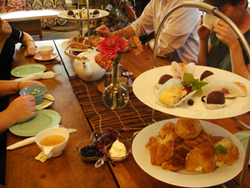The first time I had a pu erh tea, I wasn’t quite sure what to make of it. It’s an interesting tea, and a bit of an anomaly, for several reasons:
- It’s the only tea (at least to my knowledge) in which letting it get old can be a good thing. You can age pu erh like wine, and, like wine, aging the pu erh brings out a more mature, complex flavor. Fascinating, right?
- It doesn’t grow bitter from oversteeping like most other teas. You can steep this for a few seconds or for several minutes and it won’t taste weak or bitter.
- It can be pressed into cakes or bricks to be sold. This is a tradition that dates back to the days of trade caravans.
The first time I tasted pu erh, I was amazed by its dark, almost opaque liquor and its bold, earthy taste. But it had this almost…fishy note to it that was strange. Well, there was a reason it had tasted fishy. I had brewed it wrong.
The secret to a good cup of pu erh is to rinse the leaves before you actually brew it. Rinsing is very simple. If you’re making a Pu’erh in a glass or a ceramic pot (note to self: write a blog entry on Yixing clay pots. Or 12 entries.), just put your leaves in the pot or mug or Gaiwan, then put in enough boiling water to cover the leaves. Let this sit for a 2 or 3 seconds, then dump out the hot water. You might need to do a second rinse. This will clean the leaves and it will ensure that the tea you brew actually tastes like the pu erh leaves, instead of whatever stuff clung to the leaves during its aging process. You’ll get more of the pure tea taste after a good rinse.
You also don’t have to steep pu erh for nearly as long as I originally thought. While some websites said to let it steep for 5 minutes or more, others said to steep it for 20 to 30 seconds! This depends on the vessel you brew it in, and, most likely, your personal taste. The good thing about pu erh is, you can’t really mess it up. That is, you can’t brew it to the point of it tasting bitter and undrinkable, although certainly there are long traditions on the best way to make a cup of pu erh.
But the cardinal rule to pu erhs to come away with is to rinse before you infuse!


